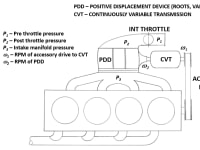For a gasoline engine, part load throttling losses account for the majority of the fuel efficiency difference between it and a diesel engine. This device can recover up to half of that loss resulting in a 10%-15% improvement in vehicle fuel economy. Many design features of today's engines such as downsizing, downspeeding, variable valve timing, and variable displacement reduce some of this throttling loss by making the engine run at at higher load factor, but there are limits to the effectiveness of these methods.
The intake throttle controls the power of an engine by controlling the air flow into the engine via restricting it. The throttle recovery device controls air flow via the rotational speed of a positive displacement device such as a Roots-type supercharger or a vane type compressor. The rotational speed of the positive displacement device is controlled by either a mechanical CVT off of the engine's accessory drive or two electric motor/generators, one powering the device and the other connected to the accessory drive. During part load operation, the intake throttle would be fully open and the air pressure before the positive displacement device would be near atmospheric while the downstream pressure would be a vacuum. This pressure differential can be converted into positive work by the device, and that work would be sent back to the engine's crankshaft via the CVT or motor/generator attached to the accessory drive. The combined efficiencies of the positive displacement device and CVT or motor/generators would determine the percentage of throttling loss recovery. This number could be as high as 50% in a well designed system.
In addition to recovering throttling loss at part loads, supercharging can also be achieved for higher loads with the proper rotational speed of the device. This device would enable the use of the Miller cycle to achieve further efficiency gains via recovery of additional cylinder expansion work. At very light loads and idle, the normal intake throttle would need to be used in conjunction with the recovery device due to limitations in the components that make up the device.
The application of this device would be mainly automotive since this device would add cost and bulk to the engine. The manufacturer's cost for adding this device to a V8 pickup truck engine would be in the $700-$1000 range. As a comparison, Ford went to aluminum bodies, Ecoboost engines, and 10-speed transmissions to achieve a similar fuel economy gain.
The technology is essentially off the shelf. Roots type superchargers are manufactured by many suppliers, notably Eaton, and low power CVT's have been in production for decades in scooters. Dana and Torotrack also make good traction type CVT's. Electric motor/generators would probably require a voltage higher than 12v, but 48v systems are starting to enter the market. A battery would also be needed in a motor/generator system to provide extra energy from idle.
See patent publication 20110030641.
Like this entry?
-
About the Entrant
- Name:Robert Rowells
- Type of entry:individual
- Patent status:none





